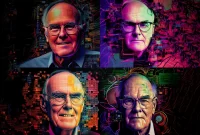The latest scientific methods for relieving depression by 2021 technology
Consecutive studies on alternative therapies for relieving depression by the National Center for Mental Health, which conducts non-biased research, have shown that even with standard doses of most antidepressants, only 30% of people with acute depression develop Prescription therapy improves.
Turning to new drugs, which often take 12 weeks to get results, works in 25% of cases. Therefore, after 24 weeks (approximately 6 months), depressive symptoms improve in only 55% of people suffering from acute depression.This is not good news for me.
And what about the other 45%?
Every day on my Beyond Blue Depression Association project, I hear from my patients that despite taking a combination of 20, 30, or even 40 different medications, they have not been able to overcome their depression and are overshadowed by the smallest issue of their entire lives.
I am personally familiar with this type of depression, so in the last two years, I have spent a lot of time and money discovering alternative therapies.
Here are 10 non-pharmacological treatments for depression that have helped some of my community members or friends who were battling the giant.
Even if you do not have drug resistance to antidepressants, knowing this is not a good thing for you and can help you in taking the drug.
Remember that although I am a very bigoted writer (but fully aware and thoroughly researched), I am not a doctor, so consult your doctor before changing medication plans.
Magnetic stimulation of the cranial nerve
It is not possible for me to count the number of people who survived depression with the treatment of magnetic stimulation of the cranial nerve. But in Martha Rhodes’ executive method it was definitely possible. He wrote in his memoirs that he treated more than 3,000 people and contributed to his achievements in acquiring this new technology.
The method of magnetic stimulation of cranial nerves is a non-invasive process that stimulates nerve cells in the brain with short magnetic waves.
A large wire ring made of an electric magnet is attached around the skull, which generates focused waves, passes through the skull, and stimulates the cerebral cortex, which stimulates the mood-regulating region. This treatment was approved by the US Food and Drug Administration in 2008.
I first heard about magnetic stimulation of cranial nerves two years ago. I started researching on my own, but the insurance company did not cover my research and I had to pay a lot of money.
However, with the relentless efforts of one of the directors of the Nerve Cells Company, the insurance tariff was increased from 100 million to 200 million people.
The results of a recent study published in the Journal of Clinical Psychiatry indicate the long-term effect and durability of the magnetic stimulation method for more than one year in adult patients.
This morning, the company announced that medical expenses would be increased to cover patients in need of non-invasive treatment.
Treatment of dialectical behavior
The treatment of dialectical behavior is another popular topic in my Depression Association. A type of cognitive-behavioral therapy introduced in the late 1980s by psychologist Marsha Line Hen, who previously treated obscure personality disorders. But today it deals with all kinds of mental disorders.
Today, one of my patients at the Beyond Blue Association told me that as someone who has suffered from depression and anxiety for years, she has learned many techniques from the dialectical support group for daily living.
The behavioral activities and mental imagery he learned from the group calmed him down, and these techniques were especially effective during times of nervous breakdowns or the onset of excruciating nostalgia.
Breathing techniques, stopping and avoiding negative thoughts and full acceptance of deep feelings without judging ourselves and when we are uncontrollable or abused, we want to make ourselves seem controllable and lovable are some of the common techniques of this treatment.
yoga
Many studies confirm that yoga helps to improve depression. In 1993, for example, 50 female students suffering from major depression practiced Shavasana Yoga for 30 days, 30 minutes each day.
These exercises significantly reduced their depression in the middle and end of the treatment period.
For 15 years, Tiagan taught yoga and overcame isolation in New Zealand, Australia, Peru and Mexico.
He has created online programs for teaching yoga and meditation to be provided free of charge to people suffering from depression and who have repeatedly tried therapeutic methods. He states that if you look at yoga exercises as an eye treatment, many of your depressive symptoms will be reduced.
Movements and pauses in the limbs, while focusing on breathing, drain the body of energy, which is trapped in the form of depression, and is released from the body. Intellectual visualizations, breathing, and components of meditation exercises help and rejuvenate the brain and reinforce the pattern of formation of new thoughts. Yoga is a powerful tool that leads to profound transformations.
Cognitive therapy based on knowledge
As I mentioned in my article on awareness a few days ago, a new study from the University of Oxford found that awareness-based cognitive therapy is as effective as antidepressants in preventing recurrence of depression.
Studies show that both awareness-based cognitive and awareness-based stress reduction schemes have far-reaching effects on depression and anxiety, and reduce common mental distress.
Last year I took an 8-week training course. As a result, I become more aware of my nervous reactions and try to reduce them before my stress subsides. I am aware of what causes me stress.
I know that my inner criticisms and visions of the future make me anxious. One of the advantages of this method is that the stress is placed in a certain point of the body (mind) and my focus is only on calming that point.
Hannah Physical Education
Alexander believes that you communicate everything to the body, whether physical, mental or spiritual, in the form of muscle tension. The muscles of our body have memory.
They tell our stories. We respond to life events with physical stress. By retelling and repeating the psychological damage these reflexive physical stresses can perpetuate and cause chronic muscle tension.
Hannah’s physical training was provided by Thomas Hannah and is based on neuromuscular training that focuses on chronic pain in a relaxed manner, facilitating movement and relieving stress.
Hannah’s physical activity specifically stimulates the sensory motor activity of forgetfulness and teaches the brain how to retrain its muscle movements.
Ryan Muskell, who practiced massage therapy in Annapolis for many years, is now practicing Hannah’s physical education. He told me that now, instead of manipulating the muscles of his clients in the form of massage therapy, he is teaching them how to do their work, how to move their muscles in a way that relieves pain and tension.
Hannah’s physical education training from a specialist gives you the power to take more control of your body and ensure your neuromuscular health throughout life.
Bipolar beat
When Anhail Rafas, author of “Worthless,” interviewed a researcher studying brain activity, he said that music activates the brain, and that a different mood can be created by using a bell beat.
In fact, this technology has been around for centuries, but it took some time to get into the treatment cycle. Several recent studies suggest that the use of biceps or auditory therapy can greatly reduce anxiety, at least in patients undergoing cataract surgery, and reduce depressive symptoms in children and adults.
Although Rafas was hesitant, he experimented. He acknowledged that as soon as the sound reached my brain, I immediately felt a change in myself, I breathed more easily, I felt light and warmth inside me, a deep, gentle and pleasant smile settled on my face, I forgot about anxiety and depression. I would say that no science, no scientist could explain it.
Although this feeling was not with him all day, at least for him, listening to music in this way brings a quick, pleasant, amazing and short-term relaxation.
Eye movement desensitization and reprocessing treatment
Two years ago, I called my friend Priscilla Warner with tears in my eyes. Disappointed with the psychiatric sessions, I tried new drugs. However, I did not benefit from any of the treatments, not from diet changes, not from meditation, not from yoga and acupuncture. I tried all the options but none worked. Priscilla suggested eye movement desensitization and reprocessing therapy. The only way he could help her get rid of her anxiety was to be effective for herself and to have a different effect on her.
Eye movement desensitization and reprocessing therapy is a psychological therapy developed by Francine Shapiro that processes painful memories using eye movements and other methods. According to the results of studies that confirm the use of this method and how it interferes with disorders and their reduction, it is now approved by some organizations. This method is a great tool for people whose depression is aggravated by any shock, acute or severe. For example, a woman named Grace, who participates in My Depression Association, explains that “this method helped me get rid of painful memories and recall them.” This method processes painful memories.
Bio Feedback
Biofeedback is a process that teaches you to have better control over your mind and body by using electronic sensors that generate feedback.
Biofeedback allows you to see on the screen how specific thoughts cause complex changes in your body, how they cause relaxation or tension in your muscles, and of course how they affect your thoughts.
With a little successful manipulation of the mind and body, you will be able to overcome your thoughts and control your body.
Take depression seriously!
You may also experience symptoms of depression: withdrawal, unhappiness for certain events, and extreme tiredness. Depression gets worse in some cases and they may experience frustration, restlessness, aggression, hatred and even crying. Depression can make you reluctant to visit, travel and party, and spend all day at home in isolation.
Depression is one of the most common mental disorders and it is estimated that one-tenth of adults are currently taking prescription antidepressants. But these drugs can have unpleasant side effects and are not necessarily the same for everyone.
Treatment with modern technology
One way to treat depression without medication is to use an rTMS device. This treatment is approved by the US Food and Drug Administration (the most reputable institution in this field) and by changing the magnetic field of certain areas of the cerebral cortex, it changes the activity of the brain. This treatment has positive effects on headaches and cases such as depression, obsessive-compulsive disorder, anxiety disorder, auditory hallucinations, Parkinson’s, bipolar disorder, facial paralysis, migraine, brain injuries such as stroke and. The experience of clinic clients in this method has been very satisfactory.
Brain Imaging Findings
An advanced scan for localized measurement of cerebral blood flow in depressed patients shows that there is a decrease in metabolism in the frontal cortex of the brain compared to healthy individuals in depressed patients. The rate of decrease in this metabolism is directly related to the severity of the disease, and after treatment and during the recovery period, the rate of metabolism returns to normal.
Severe depression following brain injury manifests itself in the lobes of the frontal region, especially in the left frontal pole. New studies obtained by PET scan in patients with refractory depression show that in addition to decreased metabolism in the frontal poles, these patients also have increased metabolic activity in the cingulate shingles (part of the limbic system).
This area of the brain In normal people, they have more blood flow when they are sad, this area of the brain responds well to antidepressants. Numerous studies by brain imaging in recent years have shown abnormal neuronal activity in sad individuals in the midline of the frontal pole, including the anterior cingulate groove and the orbito-frontal cortex.



